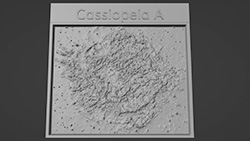CXC Home | Search | Help | Image Use Policy | Latest Images | Privacy | Accessibility | Glossary | Q&A
1
X-ray, Optical, & Infrared Images of Cassiopeia ACredit: X-ray: NASA/CXC/SAO; Optical: NASA/ESA/STScI; IR: NASA/ESA/CSA/STScI/Milisavljevic et al., NASA/JPL/CalTech; Image Processing: NASA/CXC/SAO/J. Schmidt and K. Arcand
Data from Chandra and Webb of the supernova remnant Cassiopeia A (Cas A) have been combined for the first time, helping to explain an unusual structure within the debris field and address other questions about the supernova explosion that created it. These images show X-rays from Chandra, infrared data from Webb and Spitzer, and optical data from Hubble. Astronomers using these data found that the so-called Green Monster near the center of Cas A was created by a blast wave from the exploded star slamming into material surrounding it.
2
X-ray, Optical, & Infrared Images of Cassiopeia ACredit: X-ray: NASA/CXC/SAO, NASA/JPL/Caltech/NuStar; Optical: NASA/STScI/HST; IR: NASA/STScI/JWST, NASA/JPL/CalTech/SST; Image Processing: NASA/CXC/SAO/J. Schmidt, K. Arcand, and J. Major
To learn more about the supernova explosion, scientists compared the Webb view of the pristine debris with X-ray maps of radioactive elements that were created in the supernova. They used NASA’s Nuclear Spectroscopic Telescope Array (NuSTAR) data to map radioactive titanium — still visible today — and Chandra to map where radioactive nickel was by measuring the locations of iron. Radioactive nickel decays to form iron. These additional images show NuSTAR in blue, Chandra in purple, Webb/Spitzer in gold and green, and Hubble in yellow.
3
3D Printable Files: Cassiopeia A(3D Print Credit: NASA/CXC/A. Jubett, using software by Tactile Universe/N. Bonne & C. Krawczyk & Blender)
This tactile plate features a physical relief map of Cassiopeia A based on the intensity of X-ray light from Chandra, Infrared light from Webb and Spitzer, and Optical light from Hubble. The resulting tactile plate of Cassiopeia A resembles a disk of electric light with clouds and streaks. An area near the center of the remnant resembles a somewhat circular region of lightning. X-rays from Chandra reveal hot gas, mostly from supernova debris from the destroyed star, and include elements like silicon and iron. X-rays are also present as thin arcs in the outer regions of the remnant.
Data from Webb highlights infrared emission from dust that is warmed up because it is embedded in the hot gas detected by Chandra, and from much cooler supernova debris. Hubble data shows a multitude of stars that dot the field of view.
Data from Webb highlights infrared emission from dust that is warmed up because it is embedded in the hot gas detected by Chandra, and from much cooler supernova debris. Hubble data shows a multitude of stars that dot the field of view.
Return to: NASA Telescopes Chase Down "Green Monster" in Star's Debris (January 8, 2024)
















